| |
Our 230 mile rafting journey through the heart and soul of Grand Canyon National Park ended last September. Two weeks of epic grandeur and adventure. John Wesley Powell had made the same journey 150 years earlier, a three-month expedition, traversing nearly 930 miles, starting with the Green River (that empties into the Colorado) and running nearly the entire dam-less length of the Colorado. In his ten-person party, he was the only one who wore a life jacket. All 29 (represented by eight states and three countries) of us wore life jackets to be sure. Times have changed, and in many ways, for the better. But, in some ways, not.
Powell’s was the first party sanctioned by the US government to run the Grand Canyon, and his is the first credited caucasian group to have made this journey. The one-armed, 5’7” Civil War major thus etched his name forever in the history of the Grand Canyon which celebrated its 100th year as a National Park in 2019.
Preparation and Put-in
Maui friend Bobbi Becker organized the journey (two years in advance) through AZRA (www.azraft.com, Arizona Rafting Adventures; click on the site and you’ll see some of my photos on their opening page), a company which she had used on a previous adventure. She requested Kevin Grief as the trip leader/head guide. He was perfect, level-headed, witty, expertly skilled on the rapids, and deeply knowledgeable on the geology of the Grand Canyon, honed from more than a hundred trips over the years. Our entourage was made up mainly from Bobbi’s Maui and Flagstaff, Arizona friends. Two of my dearest friends (John Paulson and Pete Smit) joined us. Our group could not have been more compatible.
AZRA had sent out a list of what to bring in preparation for our two-week journey. The day before departure, all of us met at Flagstaff’s Little America Hotel where we had a meet and greet along with final trip instructions. Pete, John and I did our final packing into assigned dry bags that evening. Bright and early the following morning, all participants boarded a AZRA bus for the several hour drive to the put-in at Lee’s Ferry, just south of the Utah border.
If you go, I highly recommend that you pay very close attention to the AZRA mandatory packing check list and the recommended (though not mandatory) ‘tips from the pros.’ I strongly suggest that you read this: https://rrfw.org/RaftingGrandCanyon/Hygiene_and_Personal_Care. Myself and eight others on our journey experienced varying degrees of tolio, a condition that I had never heard of before, that results from improper toe and foot care. After leaving the river, it disappears quickly, but it can be very painful while on the river, so read up on it in the link above and utilize preventative measures.
Additional items to consider bringing include chap-stick on a lanyard, three pairs of lightweight socks, small water filter, hiking poles (I took one and it was invaluable), unscented thick lotion and hand cream, camp chair (tho’ they provide simple chairs), gorp (your personal trail mix, salty and sweet), small plastic bowl for ants, waterproof Sherpa hiking shoes.
Just prior to our Lee’s Ferry departure, we stopped at Navajo Bridge (490 feet above the river), walked across it and had the pleasure of viewing the endangered California condor, a first for most of us.
Lee’s Ferry is 16 miles below Glen Canyon Dam. It is here where we met our seven guides and two assistants. They were all ready to roll with supplies (food, tents, sleeping gear, etc), minus our personal bags which they loaded and secured. Two members of our group (Bobbi and guide Larry Vermeeren) had hard-shelled kayaks which were their modes of transportation during the entire trip. Additionally, we had six rafts, two duckies (inflatable kayaks), an inflatable canoe, and one paddle-board (used by Robbin Voight and Ely Spivack; Ely would paddle-board over one-hundred miles of the Colorado).
The Adventure Begins
Officially we would do 160 rapids coursing 225 miles in 14 days. Pete and I rode in the bow with Kevin in the lead raft the first day with Flagstaff residents David and Jayne Williams in the stern. I journal-ed periodically during the trip and had full access to Robbin’s journal. She wrote about the first day, “Fourteen days with somewhat strangers in the wilderness. Trust, kindness, cooperation. No phone, no wifi, unplug. I’m sure that it will take a few days to adjust. The water was emerald green and so clear. Pancake Rock was my absolute favorite formation. The canyon walls are getting taller. Went through at least four rapids Class 3-5, and had one amazing bighorn sheep sighting. My life jacket’s name is ‘canyon wren.’ Caesar salad for lunch and salmon for dinner. Camp is spectacular! Hot Na Na Wash, mile 16. Amazing star-filled night. I opened my eyes several times to shadows on the canyon walls that looked like patchworks on a quilt. I awoke in the morning to the sound of canyon wrens, and there were bats flying above my head, catching bugs. Beautiful morning in the 70s with a slight breeze.”
Life in the Canyon
The cacophony, incessant chatter and fast pace of the modern world is totally cut off in the canyon. There is little or no contact with the outer world when in the embrace of the canyon. The only place to phone out is at Phantom Ranch (make sure that you have a calling card), mile marker 88, nearly a week in. In June 2019, John and I hiked down to Phantom, and spent four nights in one of the cabins (drawn by lottery).
During our two-week expedition, practically everyday we had hiking adventures, exploring some of the inner veins and arteries of the canyon. Grand Canyon is one of the Seven Wonders of the World so you can imagine the scenery was beyond extraordinary no matter where we explored. Camps for rafters on the river is first come, first served, so everyday was filled with camp wonderings. Only once did we camp with other raft campers nearby. It is leave-no-trace camping, so everything—including human waste— is brought out. The process of loading and unloading the rafts, setting up and taking down of our camps (and lunch stops) became streamlined once we got in the groove. Speaking about groove, the traveling potties are called ‘groovers.’ Two were set up at each camp, generally one on each end. Generally, all groovers had grand views ... sometimes, though rarely, you could be caught ‘grooving’ as other raft companies and private parties rafted past. ‘Good time to practice your ‘wave’ or ‘cap pull-down.’
AZRA food—prepared by the guides—was superb. Practically every evening they had dessert for us prepared via dutch oven. Yum! Yum! Especially the lemon cake. Several folks had birthdays on the journey and we celebrated each one with a special dessert and a rousing birthday tune. AZRA allows each guest to bring 42 cans of beverages of their choice. They’re kept in individual gunny sacks that remain amazingly cool stored inside a couple of rafts. My choice was Guinness Stout, coconut water and one bottle of great sipping tequila.
I slept on an open mattress for a week and inside a tent (with doors open and no rain fly) for a week. One evening while sleeping in the open, I awoke startled and there was a wild ringtail cat sniffing me from inches away. Fellow rafter Luci Motta moved her tent one evening when she spotted a rattlesnake a foot away. Pete and I moved our camp early one evening when Kevin said, “Lads, I’d recommend that you move from the grass and rocks to the beach as the spot that you have selected is scorpion heaven.” Later with black lights we viewed at least 25 scorpions where we had initially placed our bedrolls, and one was even in my river sandal which I had earlier removed. Before slipping into bed that evening, I shook one out of my life-preserver (my preserver was named Billy Burro) which I would kneel on to get into bed, and found another smaller one at the other entry of my tent on the sand. Oh yes, there are also the red ants. And they are in every camp. I was bitten several times. Once on my ear lobe which was painful and caused it to swell up for 24 hours. One remedy is to bring a plastic bowl, place it level with the ground and the ants will come tumbling in and they can’t get out, allowing you to bivouac more in peace. All of these (except for a snake bite) are minor inconveniences compared to the grandeur of this Holy canyon which you get to experience every day and night. Sleeping under the stars with the heavenly pulse of the Milky Way is sublime.
My Mom Passes
| |
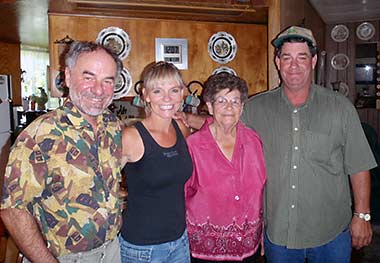 |
|
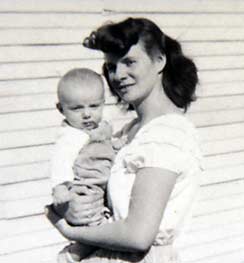 |
|
| |
|
|
|
|
| |
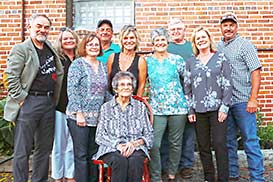 |
|
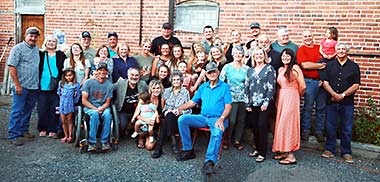 |
|
| |
|
|
|
|
When I left on the journey (it was a last minute opportunity to fulfill a life long dream), I knew that my Mom was vulnerable as she had been diagnosed with cancer earlier in the spring. But she and my sisters and brothers wanted me to go. Mom said that she would see me upon my return. Mom passed on the third evening of my journey and it was on the sixth day at Phantom Ranch that I found out with a call to my sis and brother-in-law. I sobbed. I had dedicated this expedition to my Mom before I started. It now became even more poignant. The deep embrace of the Grand Canyon consoled me—as did my fellow voyagers—the best it could, but I knew that never again would I see her mortal face nor feel her hug, nor hear her say I love you as those were the last words that both of us spoke to each other the evening before our departure on the river. Other than being at home, I think that the Grand Canyon and Colorado River was the perfect place to be to honor her and the Spirit of her remarkable life.
The River and Side Canyons
| |
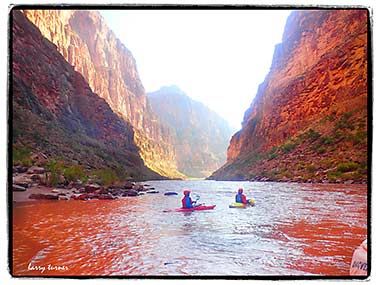 |
|
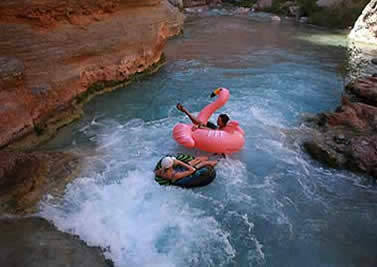 |
|
| |
|
|
|
|
| |
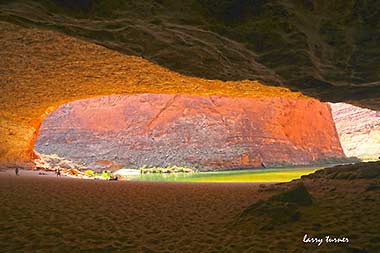 |
|
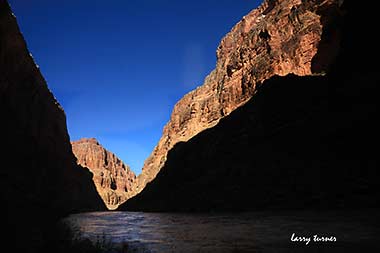 |
|
| |
|
|
|
|
| |
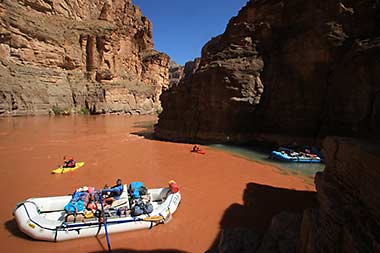 |
|
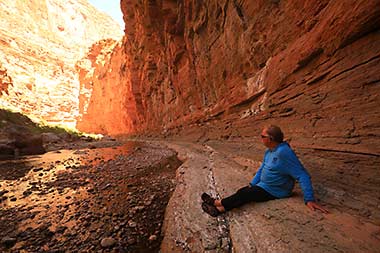 |
|
| |
|
|
|
|
| |
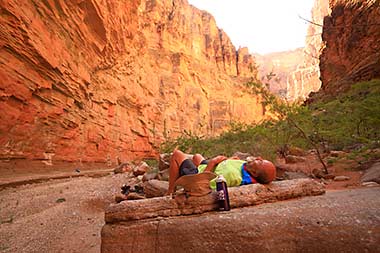 |
|
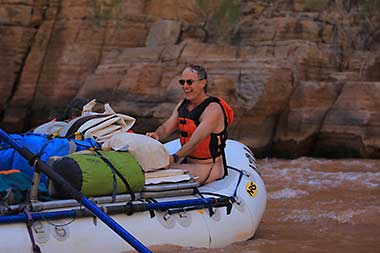 |
|
| |
|
|
|
|
| |
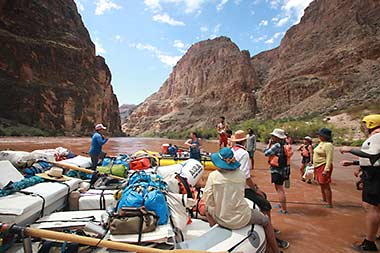 |
|
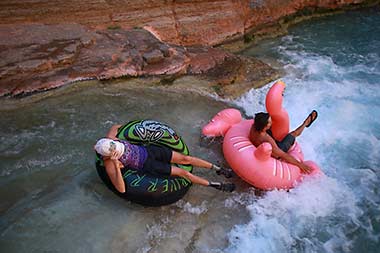 |
|
| |
|
|
|
|
| |
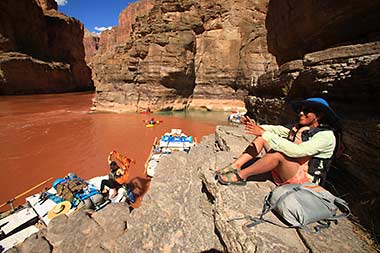 |
|
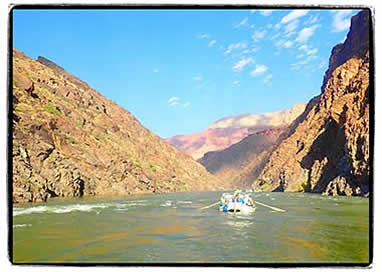 |
|
| |
|
|
|
|
| |
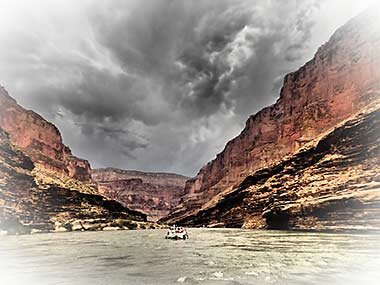 |
|
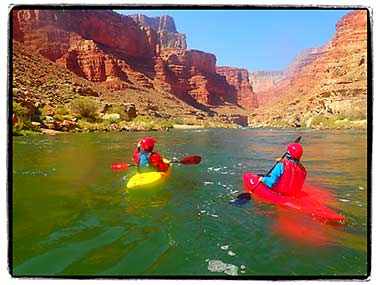 |
|
| |
|
|
|
|
| |
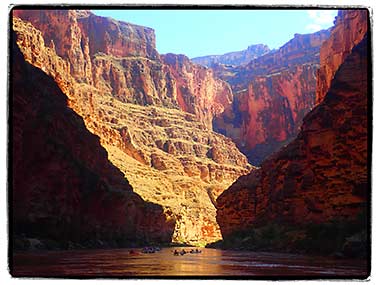 |
|
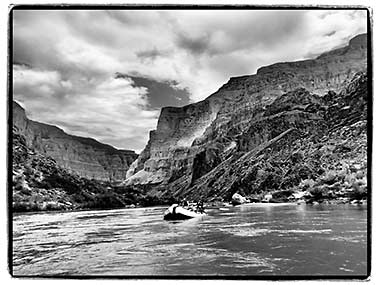 |
|
| |
|
|
|
|
| |
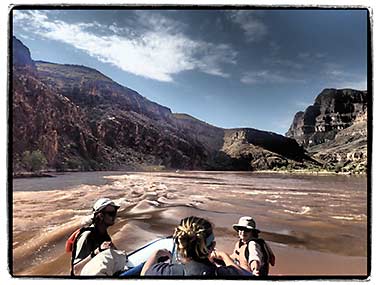 |
|
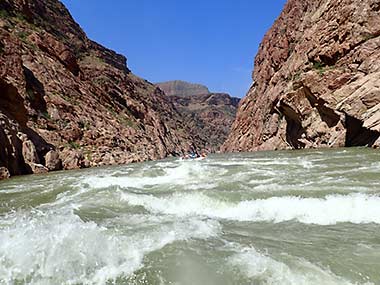 |
|
| |
|
|
|
|
The Grand Canyon Colorado River rapid rating is unlike any other. It goes from Class 1-10 (1-X) as opposed to the International Scale of River Difficulty (founded by the Americans) which goes Class 1-V1. In our 225 miles we experienced every rapid class 1-10. My personal favorite was Crystal Rapid at milepost 98. At the bow (where I rode the entire trip except for the last two days), the Class 10+ totally engulfed me and nearly pulled my iron hand grip away from the tie rope. The force of the rapid literally collapsed my chest-mounted GoPro camera so that I was photographing my crotch instead of the rapids. Just before Crystal at Milepost 95, we experienced equally thrilling 10 consecutive roller-coaster-like waves of Hermit Class 9 Rapid. The fabled Lava Falls Class 10 Rapid was exciting, too. Married couple Paul and Crystal Drumheller ran Lava Falls in the buff (life-jackets on, of course), as they had also done five previous times. Right after Lava, we pulled up on the beach for lunch and Paul brought out a $7,500, 23-year old Pappy Van Winkle bourbon with which we cheered the rapid. I must have drunk $300 worth of it!
Two notable bodies of water that spill into the Canyon’s Colorado are the Little Colorado River and Havasu Creek, both which have more of a Mediterranean, Belize look to them. Crystal clear, their white aqua-green and light blue colors contrast mightily with the Colorado’s (means red in Spanish) dirty orange-red brick hues. We hiked up both. Our guide Stephanie took a blow-up pink flamingo upriver on the Little Colorado and several of us had a rollicking good time taking it through some rapids. We swam, relaxed, played, and formed human chains, turning our life-jackets upside down to step into and wear. We were free from the waist up. Hiking back on Havasu, I had the pleasure of photographing a desert bighorn sheep that was standing in the middle of the creek. It was a surreal scene of perfect light on a wild, noble creature.
We took several side slot canyon hikes (mainly on the north-side) during the expedition. The first saunter was on the south-side, the second day: Redwall Canyon. The river here had carved out this deep, natural, cave-like amphitheater. The presence of my Mom was immense here (I later found out that this was the day before she passed). This natural cathedral was beyond human words to describe its hallowed presence. I walked alone, exploring it. Everyone was moved, one way or many ways or another, to be in the presence of such deep quiet and solemn grandeur. The colors inside, reaching out to the river and the canyon walls on the other side, were rich and varied. Robbin recorded gray, green, red, pink, black, brown, cream, yellow, wheat, tan, maroon. I added saffron, apricot, peach, lime, lemon, burgundy, claret, raspberry. I must have been hungry and thirsty.
Our lady guides Michelle and Stephanie were singers and guitar players. While oaring, they often sang songs such as ‘Angel from Montgomery.’ When we reached Blacktail Canyon, we hiked in and experienced one of the most ethereal experiences that one could ever experience in one of the deepest geological vaults on the planet where time current as we know it dances on the same floor as time nearly unfathomable. One mid-day in calmer water nearing the end of our journey, all of the rafts and kayaks tied up to each other and Kevin read from the book ‘We Swam the Grand Canyon’ as the current calmly took us downriver. Later that day, we had a robust river water fight with water guns, buckets, paddles and hands, as though we were 10 year-olds again.
As naturalist writer Ann Zwinger once penned: “ Seeing the rock go from several hundred million years old and jumping to almost 2 billion years old as it does in Blacktail makes it hard to put into perspective how this relates to our personal sense of time. The first few day of a river trip seem to go in slow motion. Then, something strange happens. The days just fly by and what happened yesterday seems to blend into what happened the day before. To fully grasp what one is feeling and experiencing on a river trip is really difficult to explain in words. To understand how our lives compare to the deep geological time represented here is nearly as difficult as understanding our place in the cosmos. Very few places but the Colorado River can provide this perspective. Beyond the rapids, the waterfalls and beaches, sometimes it is the intangible discoveries that make a river trip a life-changing event.”
Michelle and Stephanie hiked in with their music and guitars and serenaded us, themselves and Blacktail Canyon—with acoustics worthy of Pavarotti and Callas—and music that I’ll never forget, and that I will always treasure, as my tears flowed like the river, celebrating my Mom’s life.
There were several other side slot canyons that we explored, but with word and time constraints, I will explore them with you at a different time. All were complete and ongoing narratives worthy of complete chapters of their own.
The Ending and the Beginning
The river and the inner canyon walls embrace you like you were back in your mother’s womb. Metaphorically, your Mom is the raft carrying you, protecting you, your transport and lifeline on the river. Though there were many rapids, I always felt safe. The vastness and depth of the canyon sequesters you away from the world. And in awe, everyday, I embraced the beauty and grandeur around and above me. The textures, hues, formations, the play of light on the walls and river, the unexpected, the wildlife sightings (especially the abundance of desert bighorn, peregrine falcons, ravens, wrens, swifts, bats, cowbirds, red-tailed blackbirds, great blue herons and the occasional snowy egret), conversations with fellow travelers, the abundance of excitement and deep quiet, the space and purity of wilderness, the unknown.
We had experienced a variety of camps along the way with names such as Hot Na Na, Buckhorn, Nankoweap, Cave Chuar, Trinity, Mile 110, Diabase, Stone, Football Field, Hells Kitchen, Lower National, Deer Creek, Kanab. Notable hikes included Stone Creek, Deer Creek and Kanab. Blacktail Canyon touched the souls of all of us with its deep geological history, seen before our very eyes as we touched rock in one hand a billion years plus older than another in the other hand.
Kevin, at 65 with 19 years as a guide on the river, best summed up what most (if not all) of us felt at journey’s end: “The river is like home. It makes more sense than the world above the rim. A simple life. It’s rewarding to see how it affects people. It’s hard to get away from the world for two weeks. Everything is on hold. Every time I come out, I am totally revitalized and energized, and hope for the world is once again renewed.”
I had lost my Mom when on the river, and a brave new world awaits me without her physical presence. But like the ancient rocks of the river, she is with me forever and her wisdom will accompany me until my dying day.
THINGS TO CONSIDER:
Books:
The Colorado River in Grand Canyon by Larry Stevens
We Swam the Grand Canyon by Bill Beer
Day Hikes from the River: A Guide to Hikes from Camps Along the Colorado River in Grand Canyon by Tom Martin
Grand Canyon River Rafting: What to Expect and How to Prepare for Your Guided River Trip by Holly M. Stedman
The Emerald Mile: The Epic Story of the Fastest Ride in History Through the Heart of the Grand Canyon by Kevin Fedarko
Other:
www.grandcanyontrust.org
www.grandcanyonhistory.org
Off River Accommodations:
https://littleamerica.com/
www.hotelmontevista.com (highly recommended; we stayed there for two nights after getting out of the canyon)www.grandcanyon.org
www.GrandCanyonLodges.com
www.nps.gov/grca.com
|
|